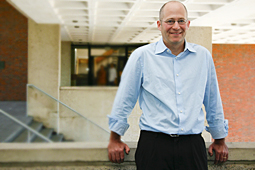English professor lands Guggenheim Fellowship
Project investigates what it means to get lost in a work of art
 Photo/Mike Lovett
Photo/Mike LovettProfessor John Plotz
When you’ve half lost yourself in a book, what happens to the half left behind?
This question, offered by John Plotz, professor of English, has landed him a Guggenheim Fellowship for the 2011-12 academic year. His current project, “Semi-Detached,” investigates what it means to get lost in a work of art.
Plotz says artworks are like virtual worlds, which allow their audiences to feel that they are simultaneously inside and outside an artwork—both in an art gallery looking at a painting, and somehow within the world that painting depicts.
“This is not complete immersion, like a gloves-and mask kind of virtual reality,” says Plotz, “but a kind of semi-detachment, which is compelling to its audiences because it never lets them forget their real-world location.”
One of the key questions Plotz asks is how different from today these semi-detached states were in the 19th century. He compares the states of partial immersion produced by novels, poems and panoramas in the Victorian age to modern-day versions of the same kind of addictive tuning out: Second Life, online gaming, even the kind of texting and Facebook-status surfing that’s probably happening around you at the moment.
“In the Victorian era it would be something like a panorama or an opera,” says Plotz. “It was such a powerful and all-surrounding aesthetic experience that people would describe it as forgetting their real life; they would just be inside that world.”
The question, says Plotz, is how different their experience is from our own. Do we have the same experience that Victorian novel-readers did, only with different technology, or is what we experience nowadays, thanks to the Web, to smart phones, to iPads (fill in your favorite new toy here) genuinely different?
His work begins in the age of the novel, where he writes a lot about Victorian paintings.
“They loved their paintings the way that they loved their novels; both of them were immersion machines,” says Plotz. “Victorian audiences were constantly asking questions about their paintings that they would ask about their novels: Who do I identify with? What would I do if I were on that street?”
Plotz’s “Semi-Detached: The Aesthetics of Partial Absorption” includes work on J.S. Mill, Lawrence Alma-Tadema, George Eliot, William Morris, Henry James, Edmund Wilson, Hannah Arendt, and Erving Goffman.
“There’s a new phrase that people studying the Internet use called remediation,” says Plotz. “What happens when art crosses over from one medium into another; what happens when you try to put a painting into a novel, when you try to depict a novel on screen? My project is a lot about remediation – about how you would compare the different genres in art.”
Now in its 87th annual competition, this year the John Simon Guggenheim Memorial Foundation awarded 180 fellowships, to artists, scientists, and scholars, who were chosen from a group of nearly 3,000 applicants. They range in age from 27 to 84 and hail from across the United States and Canada. Their fellowship projects will take many of them across the world.
In addition to Plotz, other fellows include Bonnie Jo Campbell, a novelist who traveled with the Ringling Brothers and Barnum & Bailey circus for five months who will write a series of stores set in a contemporary American circus revealing the social hierarchy in this multicultural institution and anthropologist Jennifer Robertson, who will conduct research on service robots, focusing on their safety, security and convenience in relation to the political economy of Japan.
The John Simon Guggenheim Memorial Foundation was established in 1925 by former U.S. Senator Simon Guggenheim and his wife, in memory of their 17-year-old John Simon Guggenheim, the elder of their two sons, who died April 26, 1922.
In his initial letter of gift, the senator wrote that the foundation has sought from its inception to "add to the educational, literary, artistic, and scientific power of this country, and also to provide for the cause of better international understanding."
The initial $3 million endowment has grown to over $260 million and serves 180 fellowships in 78 fields such as computer science, astrophysics and African studies.
Since it was first established in 1925, the foundation has awarded grants to more than 17,000 individuals.
Categories: Humanities and Social Sciences, Research






